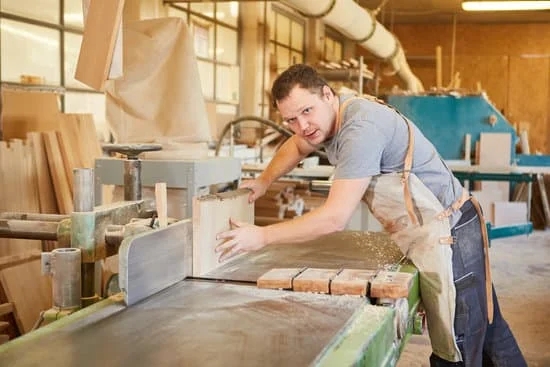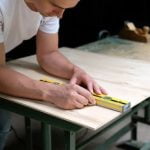Are you looking to enhance your woodworking projects with strong and concealed joints? Learn how to make pocket holes woodworking, a technique that has revolutionized the way woodworkers join pieces together. Pocket holes provide a simple yet effective method for creating sturdy connections without the need for visible fasteners on the outside of your project.
Pocket holes offer a versatile solution for various woodworking applications, from constructing furniture to building cabinets and shelves. By learning how to make pocket holes, you can expand your repertoire of joinery techniques and achieve professional-looking results in your projects. This introduction will guide you through the basics of pocket holes, including the benefits, tools needed, step-by-step instructions, and helpful tips for successful outcomes.
As you delve into the world of pocket hole joinery, you’ll discover how this method can streamline your woodworking process and elevate the quality of your creations. With the right tools and guidance, mastering the art of creating pocket holes will open up endless possibilities for designing and building custom pieces with seamless joints. Explore the following sections to deepen your understanding of pocket holes and unlock their full potential in your woodworking endeavors.
Benefits of Using Pocket Holes in Woodworking Projects
Pocket hole joinery is a popular technique in woodworking that offers several benefits for both beginners and experienced woodworkers alike. Here are some key advantages of using pocket holes in your woodworking projects:
- Strength and Durability: Pocket hole joints create strong and durable connections between pieces of wood, making them ideal for furniture, cabinets, and other structural projects.
- Speed and Efficiency: Making pocket holes is a quick and efficient way to join wood pieces together without the need for complex joinery techniques or specialized tools.
- Hidden Joints: Pocket hole screws are inserted on the inside of the joint, resulting in a clean and seamless finish with no visible fasteners on the surface of the project.
In order to make pocket holes in your woodworking projects, you will need a few essential tools and materials. Here is a list of items that are necessary for creating strong and secure pocket hole joints:
- Pocket Hole Jig: A pocket hole jig is a specialized tool that helps guide the drill bit at the correct angle and depth to create perfect pocket holes.
- Clamps: Clamps are used to secure the workpieces in place while drilling pocket holes to ensure accurate alignment.
- Screws: Pocket hole screws come in various lengths and types, so be sure to choose the appropriate size for your project.
Learning how to make pocket holes in woodworking projects can greatly expand your skill set as a woodworker. With the right tools, materials, and techniques, you can create strong, versatile joints that will enhance the durability and aesthetics of your woodworking creations.
Tools and Materials Needed for Making Pocket Holes
Essential Tools for Making Pocket Holes
When it comes to creating strong and sturdy joints in woodworking projects, pocket holes are a popular choice. To make pocket holes, you will need a few essential tools. The primary tool in making pocket holes is a pocket hole jig.
This tool helps you drill angled holes accurately and consistently. There are various types of pocket hole jigs available in the market, from simple ones for beginners to more advanced models for professionals. Additionally, you will need a drill and specialized pocket hole screws designed to fit snugly into the pocket holes.
Materials Required for Making Pocket Holes
In addition to the necessary tools, you will also need specific materials to successfully make pocket holes in your woodworking projects. The main material required is wood, preferably with the appropriate thickness for creating strong joints. Choosing high-quality wood is essential to ensure the durability and longevity of your finished project. You will also need pocket hole plugs if you wish to conceal the pocket holes for a cleaner aesthetic appearance once the project is complete.
Safety Gear and Additional Accessories
When working with woodworking tools, safety should always be a top priority. Make sure to wear eye protection and hearing protection when using power tools such as drills to prevent any potential accidents. Additionally, having clamps handy can help secure your workpiece in place while drilling pocket holes.
Other optional accessories that can aid in making perfect pocket holes include depth collars for precise drilling depth control and dust collection attachments to keep your workspace clean and free of debris. By having the necessary tools, materials, safety gear, and accessories on hand, you can successfully create professional-looking pocket holes in your woodworking projects.
Step-by-Step Guide on How to Make Pocket Holes
Pocket holes are a versatile and efficient way to join pieces of wood together in woodworking projects. Whether you are a beginner or an experienced woodworker, mastering the technique of creating pocket holes can greatly enhance the strength and aesthetics of your finished pieces. In this step-by-step guide, we will walk you through the process of making pocket holes and provide tips on how to achieve professional results.
To create pocket holes, you will need a few tools and materials. Here is a list of what you will need:
- Pocket hole jig
- Drill with the appropriate drill bit size (usually 3/8 inch)
- Pocket hole screws
- Workpiece(s) that you want to join together
- Clamp to secure the jig in place
Once you have gathered all the necessary tools and materials, follow these steps to make pocket holes:
- Set up your pocket hole jig according to the thickness of your workpiece.
- Secure the jig in place using a clamp.
- Insert your drill bit into the jig and adjust its depth stop collar based on the length of your screws.
- Position your workpiece against the jig and drill into it at a 15-degree angle until you reach the desired depth.
- Repeat the process for each pocket hole needed on your workpiece.
By following these steps carefully and using the right tools, you can achieve strong and seamless pocket holes in your woodworking projects. Experiment with different types of joints and designs to further expand your woodworking skills and create stunning pieces that showcase your craftsmanship.
Tips and Tricks for Perfectly Aligned Pocket Holes
When it comes to woodworking projects, achieving perfectly aligned pocket holes can make a significant difference in the overall quality and aesthetics of the finished piece. Fortunately, there are several tips and tricks that can help you master the art of creating precise pocket holes.
One of the key factors in achieving perfectly aligned pocket holes is using the right tools and materials. Investing in a quality pocket hole jig can make a world of difference in ensuring accurate hole placement. Additionally, using sharp drill bits specifically designed for pocket hole joinery can help prevent tear-out and produce clean, crisp holes.
Another vital tip for creating perfectly aligned pocket holes is to pay close attention to the depth setting on your drill. Adjusting the depth collar on your drill bit according to the thickness of your wood material is crucial for ensuring that the screw heads sit flush with the surface once assembled. This step may require some trial and error but is essential for a professional-looking finish.
Lastly, taking your time and double-checking your measurements before drilling can go a long way in preventing costly mistakes. Remember to clamp your workpieces securely in place before drilling to avoid any shifting or misalignment. By following these tips and tricks diligently, you’ll be well on your way to mastering how to make pocket holes woodworking with precision and efficiency.
| Tips and Tricks | Benefits |
|---|---|
| Use quality tools like a pocket hole jig | Ensure accurate hole placement |
| Adjust drill depth according to wood thickness | Prevent screws from protruding |
| Double-check measurements before drilling | Avoid costly mistakes |
Different Types of Jigs for Creating Pocket Holes
Pocket hole jigs are essential tools for creating strong and precise pocket holes in woodworking projects. There are various types of jigs available on the market, each offering unique features and benefits. One of the most popular types is the portable pocket hole jig, which is convenient for on-the-go projects and smaller woodworking tasks. These jigs typically come with adjustable guides to accommodate different wood thicknesses and angles.
Another common type of jig is the benchtop pocket hole jig, which is more suitable for larger woodworking projects that require accuracy and stability. These jigs are usually equipped with clamps or a built-in workbench for secure positioning during drilling. Additionally, some benchtop jigs have additional features like dust collection systems to keep your workspace clean.
For those looking to invest in top-of-the-line equipment, there are also automated pocket hole machines available. These machines can quickly create multiple pocket holes with precision and efficiency, making them ideal for high-volume production or professional woodworking ventures. While these machines may come at a higher price point, they can significantly speed up the process of creating pocket holes without compromising quality.
| Type of Jig | Features |
|---|---|
| Portable Pocket Hole Jig | Adjustable guides for different wood thicknesses and angles |
| Benchtop Pocket Hole Jig | Clamps or built-in workbench for stability; dust collection systems |
| Automated Pocket Hole Machine | Create multiple holes quickly with precision; ideal for high-volume production or professional use |
Common Mistakes to Avoid When Making Pocket Holes
When it comes to woodworking, making pocket holes is a common technique used to join pieces of wood together seamlessly. However, there are certain mistakes that beginners and even seasoned woodworkers can make when creating pocket holes. By being aware of these common pitfalls and knowing how to avoid them, you can ensure the success of your woodworking projects.
Not Using the Correct Drill Bit
One of the most common mistakes when making pocket holes is using the wrong drill bit. Pocket hole jigs typically come with their own specific drill bit designed to create the perfect pocket hole. Using any other type of drill bit can result in a hole that is too big or too small, leading to a loose or tight joint. Make sure to always use the recommended drill bit for your pocket hole jig to ensure precise and secure connections.
Incorrect Placement of Pocket Holes
Another mistake to avoid is placing your pocket holes in the wrong position on your workpiece. If the pocket holes are not aligned properly, it can affect the overall strength and stability of your project. Before drilling any holes, carefully mark and measure where each pocket hole should be placed according to your design plans. Double-checking your placement will save you from having to redo any work later on.
Skipping Clamping Steps
Clamping your workpiece securely before drilling pocket holes is crucial for ensuring accuracy and preventing shifting during the process. Skipping this step or not applying enough pressure with clamps can lead to misaligned holes and poorly joined pieces. Take the time to properly clamp down your workpiece before drilling to maintain control and improve the overall quality of your pocket holes.
By paying attention to these common mistakes and taking steps to avoid them, you can elevate your woodworking skills and create professional-looking projects with perfectly sized and placed pocket holes. Remember that practice makes perfect, so don’t get discouraged by initial setbacks. With time and experience, you’ll become more confident in creating flawless pocket holes for all your woodworking endeavors.
Creative Ways to Incorporate Pocket Holes in Woodworking Designs
Incorporating pocket holes in woodworking designs not only adds structural strength but also provides a clean and seamless finish to your projects. While pocket holes are commonly used to join pieces of wood at right angles, there are creative ways to utilize them in unique designs that elevate the overall aesthetic of your work.
One creative way to incorporate pocket holes is by using them to create hidden fastenings for floating shelves. By placing the pocket holes on the underside of the shelf, you can securely attach it to the wall while maintaining a sleek and minimalistic look on the surface.
Another innovative way to use pocket holes is by incorporating them into furniture designs where traditional joinery methods may be challenging or impractical. For example, when constructing a chair with intricate angles and curves, pocket holes can provide a strong and reliable connection without compromising the design aesthetic.
Additionally, pocket holes can be strategically placed in hidden areas of furniture pieces, such as under tabletops or within cabinet frames, to ensure stability while keeping visible screws or nails to a minimum.
Furthermore, integrating pocket holes in woodworking designs allows for easy disassembly and reassembly of furniture pieces for transportation or storage purposes. By utilizing removable screws in conjunction with pocket holes, you can create modular furniture that can be easily taken apart and put back together without compromising its structural integrity.
This flexibility in design not only makes furniture more versatile but also simplifies maintenance and repairs in the long run. Experimenting with different placements and applications of pocket holes can unlock a world of possibilities for creating innovative and functional woodworking designs that stand out from traditional joinery techniques.
Conclusion and Final Thoughts on Mastering Pocket Holes Woodworking
In conclusion, mastering the art of creating pocket holes in woodworking can greatly enhance the efficiency and strength of your projects. By following the step-by-step guide and using the right tools and materials, you can easily incorporate this technique into your designs. The benefits of using pocket holes are numerous, from improved joint stability to seamless aesthetics.
One of the key takeaways from this article is the importance of precision and attention to detail when making pocket holes. Ensuring that your holes are perfectly aligned and at the correct angle will result in a professional-looking finish. Remember to utilize jigs specifically designed for creating pocket holes to streamline the process and achieve consistent results every time.
Ultimately, practicing and experimenting with different ways to incorporate pocket holes in your woodworking projects will expand your design possibilities. Whether it’s joining pieces of furniture or constructing unique structures, mastering this technique opens up a world of creative opportunities. So, don’t hesitate to dive into the world of pocket holes woodworking and see how it can elevate your craftsmanship to new heights.
Frequently Asked Questions
How Do You Make Pocket Holes in Wood Without a Jig?
Making pocket holes in wood without a jig can be tricky, but it is possible with the right tools and techniques. One method is using a simple drill bit like a Kreg Jig Mini or a pocket hole pilot bit. By controlling the angle and depth of the drill, you can create pocket holes effectively.
What Tool Makes Pocket Holes?
The primary tool used to make pocket holes is a pocket hole jig. There are various types of pocket hole jigs available in the market, ranging from basic models to more advanced ones like the Kreg Jig Master System. The jig helps guide the drill to create precise pocket holes at the desired angle and depth.
What Are the Rules for Pocket Holes?
When it comes to creating pocket holes, there are some essential rules to follow for successful results. First and foremost, always use the appropriate drill bit size for your pocket hole jig.
Secondly, set your drilling speed correctly to prevent splintering or overheating of the wood. Lastly, make sure to clamp down your workpiece securely before drilling to avoid any movement or shifting that could result in inaccurate pocket holes.

Hi everyone! I’m a woodworker and blogger, and this is my woodworking blog. In my blog, I share tips and tricks for woodworkers of all skill levels, as well as project ideas that you can try yourself.





